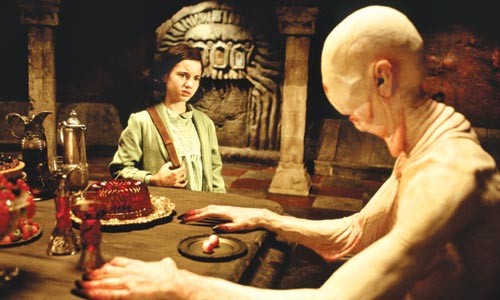Guillermo del Toro's stunning Pan's Labyrinth is a dark fairy tale for adults, a masterfully intertwined blend of psychological drama, the fantastic and an elegy to childhood innocence, set within the shadow of the Spanish civil war.
In 1944, the prepubescent Ofelia (Ivana Baquero) and her mother, Carmen, journey to a remote corner of Spain to join Carmen's new husband, an army captain, at a rural military outpost. From here, Labyrinth offers several interlocking narratives: Ofelia's struggles with her cold new stepfather and with her mother's difficult pregnancy; the military post's commission to rout stragglers from the 1936-39 resistance from the nearby woods; the collusion of the housekeeper, Mercedes (Maribel Verdu), with the rebels; and, most dramatically, Ofelia's expeditions to a fantastical secret world.
A sensitive child given to reading fairy tales, Ofelia is willingly led to this other world by an insect-fairy. Beneath a crumbling labyrinth on the property's fringe, she meets an oversized faun (Doug Jones) who tells her that she is the mortal vessel for a long-lost princess of a beautiful underground kingdom -- hers to reclaim, should she wish.
Prior to their Disneyfication, many fairy tales were horror stories that explicitly put children in peril -- from both the everyday cruelty of family and community, and from terrifying creatures and otherworldly scenarios. If -- if -- the child persevered, it was due to her own resources: courage, purity of heart, cleverness in the face of trickery.
While such stories were designed to entertain -- who doesn't like a vicarious romp through the deep, dark woods? -- they also served to educate and warn: The world is dangerous, hard to navigate, and you will be on your own.
Here, del Toro, who also scripted, hews to these Old World fairy tales, easily borrowing their familiar settings (a ramshackle home set on the edge of a forest full of dangers); motifs (magical books, keys and portals); and narrative structures: The faun sets Ofelia to three increasingly difficult tasks, including one with the requisite temptation.
Beyond the film's captivating story, there's also the thrill of seeing a young director blossom and hit all his marks. Pan's Labyrinth is a heady synthesis of themes and techniques that the Mexican filmmaker has previously explored, from the loss of innocence set against the same civil war in the slightly supernatural 2001 drama The Devil's Backbone to the fully realized fantasy world of the comics adaptation Hellboy. It's among the rare films that feels like a complete package, with the singularity of the director's vision fully realized, and ably supported by a superior cast and top-notch production values.
Del Toro wisely balances the weirdly beautiful, otherworldly set pieces so that they don't overwhelm the story; our visits are as fleeting and tantalizing as Ofelia's. Every bit of the film appears purposeful, yet del Toro obliges the mysterious by leaving aspects unexplained, such as the pagan-like stone totems Ofelia is enchanted by. Likewise the threatening yet mournful, hairless humanoid, the Pale Man (also portrayed by Jones), whom Ofelia encounters in the other world. His provenance is unknown (though the eyes set in his hands are surely a nod to Cocteau's Blood of the Poet). But due to del Toro's carefully constructed mood-mix of wonder and foreboding, we unquestioningly believe and fear.
If you're a thinking-cinema sort, you'll likely be tempted to keep your brain keyed to making connections between the allegorical and the historical. But I recommend that at least on first viewing, you simply absorb the film, letting your mind steep in its various overlapping meanings.
Many of the parallels are explicit: Franco's Spain is embodied in Ofelia's new stepfather, Capt. Vidal, whose paper-thin veneer of civility barely conceals his intractable and sadistic nature. To Vidal, chillingly portrayed by Sergi Lopez, order is honorably maintained through cruelty; his mandate precipitates the film's few scenes of startling violence. Ofelia may be given to dreams of fairies, but in the real world, she's also cunning, practical and quietly rebellious: With her muddied clothes and forays to the forest, she's aligned with the ragtag rebels and their earthy humanity, and not the crisply uniformed rigidity of her new father (read: government). Labyrinth, with its storylines shifting between reality and fantasy, also suggests that the endlessly romanticized Spanish resistance might be a what-if fairy tale of contemporary origins.
Del Toro depicts the real world as horrifying: While fairy tales can offer magical loopholes and lucky escapes, there's no such guarantee in reality. Labyrinth is largely a harrowing, somber affair. Ofelia's other world holds the promise of happiness -- yet it too is fraught with danger. And can Ofelia even trust her faun guide, historically a figure prone to charming maidens? (Mercedes, in an unexplained aside, tells Ofelia that her mother cautioned her never to trust fauns.)
Throughout the film, del Toro masters that tricky feat where the fantastical sequences feel integral to the real-life narrative. Yet Labyrinth leaves open the possibility that this other world exists only within Ofelia's imagination, that it is simply the escape of a troubled child. Even the film's conclusion is an appropriately uneasy resolution that leaves the ambiguous narrative intact. In this or any other worthy fairy tale, sophisticated storytelling doesn't change the kernel of truth: This world is no place for innocents. In Spanish, with subtitles. 















